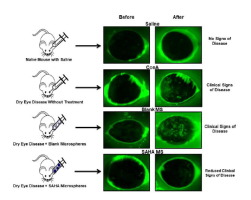Acta Biomaterialia ( IF 9.7 ) Pub Date : 2018-03-09 , DOI: 10.1016/j.actbio.2018.03.002 Michelle L Ratay 1 , Stephen C Balmert 1 , Ethan J Bassin 2 , Steven R Little 3

|
Dry eye disease (DED), also known as keratoconjunctivitis sicca, is an ocular surface disease characterized by T-cell-mediated inflammation. Current therapeutics, such as immunosuppressive agents, act to suppress the clinical signs and inflammation. However, long-term usage of these treatments can cause severe side effects. In this study, we present an alternative therapeutic approach that utilizes a histone deacetylase inhibitor (HDACi) to regulate transcription of a variety of immunomodulatory genes. Specifically, HDACi have emerged as a potential anti-inflammatory agent, which can modulate the functions of a subset of suppressive T lymphocytes known as regulatory T cells (Tregs), enhancing FoxP3 acetylation and subsequently guarding the transcription factor from proteasomal degradation. Here, a specific HDACi known as SAHA (suberoylanilide hydroxamic acid) was formulated to controllably release in the lacrimal gland. Intralacrimal gland injection of PLGA-based SAHA microspheres prevented clinical signs of DED in mice with Concanavalin A-induced DED, reduced expression of pro-inflammatory cytokines, and increased expression of FoxP3 in the lacrimal glands. Murine T cell culture experiments also revealed that SAHA decreased effector T cell proliferation and enhanced suppressive function of Tregs in co-cultures of Tregs and effector T cells.
Statement of Significance
In this study, we demonstrate a therapeutic approach that utilizes a histone deactylase inhibitor (HDACi) to regulate transcription of a variety of immunomodulatory genes. HDACi have emerged as a potential anti-inflammatory agent, which can modulate the functions of a subset of suppressive T lymphocytes known as regulatory T cells (Tregs). Here, HDACi microspheres composed of a biocompatible and biodegradable polymer (poly(lactic-co-glycolic acid) (PLGA)), were able to locally release the HDACi and prevent clinical signs of DED. This work is timely given the recent shift in treatments of DED towards immunological based therapies to reduce ocular inflammation. However, notably, many of these treatments require large amounts of drug, and non-specifically suppress the immune system, leading to several systemic side effects. Instead of merely suppressing or blocking inflammation, the formulation described herein intends to balance the microenvironment promoting immunological homeostasis. This particular drug delivery system may also have broad implications in the field of inflammatory mediated ocular disorders such as uveitis, Sjögren’s syndrome, allergic conjunctivitis.
中文翻译:

控制释放 HDAC 抑制剂以减少干眼症的炎症
干眼病 (DED),也称为干燥性角膜结膜炎,是一种以 T 细胞介导的炎症为特征的眼表疾病。当前的治疗剂,例如免疫抑制剂,可以抑制临床症状和炎症。然而,长期使用这些治疗可能会导致严重的副作用。在这项研究中,我们提出了一种替代治疗方法,该方法利用组蛋白去乙酰化酶抑制剂 (HDACi) 来调节多种免疫调节基因的转录。具体来说,HDACi 已成为一种潜在的抗炎剂,它可以调节被称为调节性 T 细胞 (Tregs) 的抑制性 T 淋巴细胞亚群的功能,增强 FoxP3 乙酰化并随后保护转录因子免受蛋白酶体降解。这里,一种称为 SAHA(辛二酰苯胺异羟肟酸)的特定 HDACi 被配制用于在泪腺中可控地释放。泪腺内注射基于 PLGA 的 SAHA 微球可防止伴刀豆球蛋白 A 诱导的 DED 小鼠出现 DED 的临床症状,降低促炎细胞因子的表达,并增加泪腺中 FoxP3 的表达。鼠 T 细胞培养实验还表明,SAHA 在 Treg 和效应 T 细胞的共培养物中降低了 Treg 的增殖并增强了 Treg 的抑制功能。FoxP3 在泪腺中的表达增加。鼠 T 细胞培养实验还表明,SAHA 在 Treg 和效应 T 细胞的共培养物中降低了 Treg 的增殖并增强了 Treg 的抑制功能。FoxP3 在泪腺中的表达增加。鼠 T 细胞培养实验还表明,SAHA 在 Treg 和效应 T 细胞的共培养物中降低了 Treg 的增殖并增强了 Treg 的抑制功能。
重要性声明
在这项研究中,我们展示了一种利用组蛋白去乙酰化酶抑制剂 (HDACi) 来调节多种免疫调节基因转录的治疗方法。HDACi 已成为一种潜在的抗炎剂,它可以调节称为调节性 T 细胞 (Tregs) 的抑制性 T 淋巴细胞亚群的功能。在这里,HDACi 微球由生物相容和可生物降解的聚合物(聚乳酸-乙醇酸)(PLGA)),能够局部释放 HDACi 并预防 DED 的临床症状。鉴于最近 DED 的治疗转向基于免疫学的疗法以减少眼部炎症,这项工作是及时的。然而,值得注意的是,许多这些治疗需要大量药物,并且非特异性抑制免疫系统,导致一些全身性副作用。本文所述的制剂不仅仅是抑制或阻断炎症,还旨在平衡促进免疫稳态的微环境。这种特殊的药物输送系统也可能在炎症介导的眼部疾病领域具有广泛的意义,例如葡萄膜炎、干燥综合征、过敏性结膜炎。


























 京公网安备 11010802027423号
京公网安备 11010802027423号